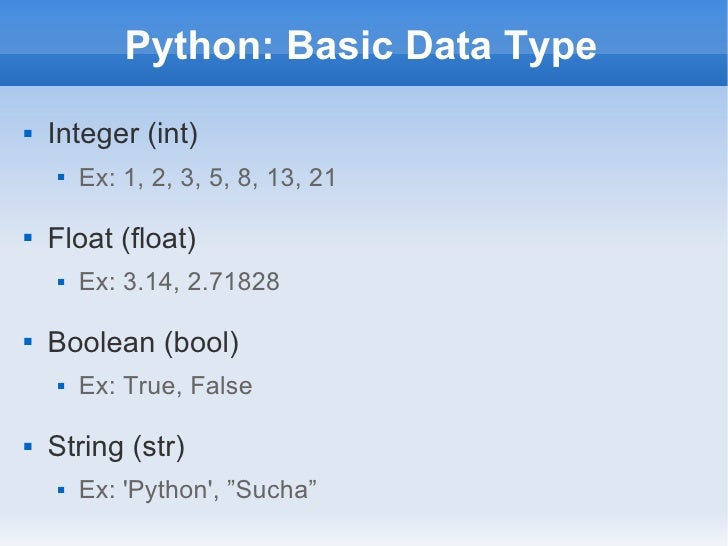Python Convert Int To String
String’s join in python: Python string class provides a member function join i.e. Join (iterable sequence) It joins all the elements in iterable sequence by separatorstring. We will use this to convert list to a string. Python: How to convert a list to dictionary?
- Python Convert Int To String For Print
- Python Convert Int To String Unicode
- How To Convert String To Float Python
Jepler it.is. a string. Because most of the characters are not printable, they're presented using hex notation when you repr the string.
That's what entering an expression in the interactive interpreter does (except that it never prints 'None'). If you really want to write whatever those bytes are, then do something like or Jeff - next part - A non-text attachment was scrubbed. Name: not available Type: application/pgp-signature Size: 189 bytes Desc: not available Url.
Larry Bates It contains non-printing and non-ASCII characters so it can't be printed lie you want. The best Python can do is to show you the hexadecimal of those bytes (as it has done). Printable ASCII characters lie in the range 32 decimal (20 hex) to 125 decimal (7F hex). Those characters in that range are shown properly. Example: There is no printable ASCII character for the first character which is x01. My ASCII table shows that this character represents an ASCII SOH (start of heading) character.
It contains non-printing and non-ASCII characters so it can't beprinted lie you want. The best Python can do is to show youthe hexadecimal of those bytes (as it has done). Printable ASCIIcharacters lie in the range 32 decimal (20 hex) to 125 decimal(7F hex). Those characters in that range are shown properly.Example: There is no printable ASCII character for the firstcharacter which is x01. My ASCII table shows that thischaracter represents an ASCII SOH (start of heading) character.-Larry BatesJava and Swing wrote. Magnus Lycka What did you expect this string to print?
Where did it come from? Viewed as ASCII it's mainly non-printables, with o, +, d, E, a/I, G, Q and H stuffed in, but I'm pretty sure it isn't 8 bit text in any normal encoding.
The only reason to suspect that this might be text after all, is that it ends with a carriage return. Converting your string to numbers, we get. 1 238 30 111(o) 195 43(+) 139 131 250 100(d) 246 69(E) 170 14 97(a) 47(/) 73(I) 150 131 245 71(G) 163 13 81 (Q) 252 72(H) 238 13. X'x01xeex1eoxc3+x8bx83xfadxf6Exaax0ea/Ix96x83xf5Gxa3rQxfcHxeer'According to, this is'Unsigned Hexidecimal (lowercase)'.
Happy with their distinctive craft they need become obsessed to the purpose of worship, turning weapons to faith. Stick war legacy hacked apk.

How can I get this into normalAscii so that I can read it?What did you expect this string to print? Where did it come from?Viewed as ASCII it's mainly non-printables, with o, +, d, E, a/I,G, Q and H stuffed in, but I'm pretty sure it isn't 8 bit textin any normal encoding.
Python Convert Int To String For Print

Python Convert Int To String Unicode
The only reason to suspect that this mightbe text after all, is that it ends with a carriage return.Converting your string to numbers, we get.1 238 30 111(o) 195 43(+) 139 131 250 100(d) 246 69(E) 170 14 97(a)47(/) 73(I) 150 131 245 71(G) 163 13 81 (Q) 252 72(H) 238 13.You can find the definition of ASCII via Google.
How can I convert a string of bytes into an int in python?Say like this: 'yxccxa6xbb'I came up with a clever/stupid way of doing it: sum(ord(c) from timeit import Timer Timer('struct.unpack(' Timer('int('yxccxa6xbb'.encode('hex'), 16)').timeit1.750244My hacky method: Timer('sum(ord(c) Timer('import structnstruct.unpack('L', 'yxccxa6xbb')0').timeit0.7380371Including the cost of importing the module negates almost all of the advantage that this method has. I believe that this will only include the expense of importing it once for the entire benchmark run; look what happens when I force it to reload every time: Timer('reload(struct)nstruct.unpack('L', 'yxccxa6xbb')0', 'import struct').timeit07888794Needless to say, if you're doing a lot of executions of this method per one import than this becomes proportionally less of an issue. It's also probably i/o cost rather than cpu so it may depend on the capacity and load characteristics of the particular machine. reduce(lambda s, x: s.256 + x, bytearray('yxccxa6xbb'))Test 1: inverse: hex'0x79cca6bb'Test 2: Number of bytes 8: reduce(lambda s, x: s.256 + x, bytearray('AAAAAAAAAAAAAAA'))068225LTest 3: Increment by one: reduce(lambda s, x: s.256 + x, bytearray('AAAAAAAAAAAAAAB'))068226LTest 4: Append one byte, say 'A': reduce(lambda s, x: s.256 + x, bytearray('AAAAAAAAAAAAAABA'))13465921LTest 5: Divide by 256: reduce(lambda s, x: s.256 + x, bytearray('AAAAAAAAAAAAAABA'))/091068226LResult equals the result of Test 4, as expected. I was struggling to find a solution for arbitrary length byte sequences that would work under Python 2.x. Finally I wrote this one, it's a bit hacky because it performs a string conversion, but it works. Function for Python 2.x, arbitrary length def signedbytes(data):'Convert a bytearray into an integer, considering the first bit assign.
The data must be big-endian.' 'negative = data0 & 0x80 0if negative:inverted = bytearray(d% 256 for d in data)return -signedbytes(inverted) - 1encoded = str(data).encode('hex')return int(encoded, 16)This function has two requirements:.The input data needs to be a bytearray.
How To Convert String To Float Python
You may call the function like this: s = 'yxccxa6xbb'n = signedbytes(s).The data needs to be big-endian. In case you have a little-endian value, you should reverse it first: n = signedbytes(s::-1)Of course, this should be used only if arbitrary length is needed. Otherwise, stick with more standard ways (e.g. A decently speedy method utilizing array.array I've been using for some time:predefined variables: offset = 0size = 4big = True # endianarr = array('B')arr.fromstring('x00x00xffx00') # 5 bytes (encoding issues) 0, 0, 195, 191, 0to int: (read) val = 0for v in arroffset:offset+size::pow(-1,not big): val = (val(i.